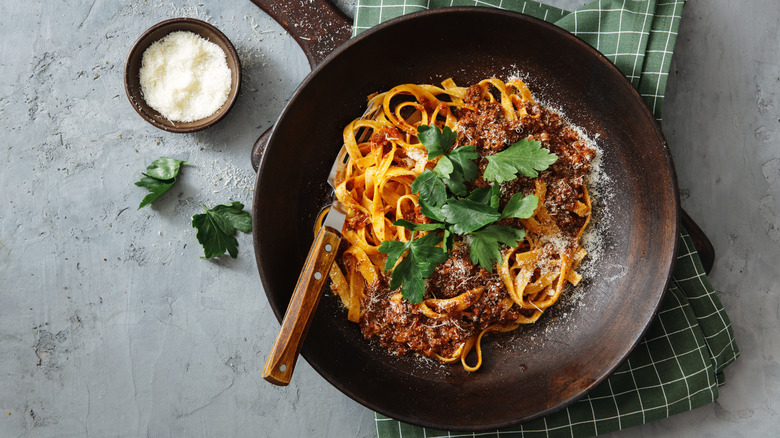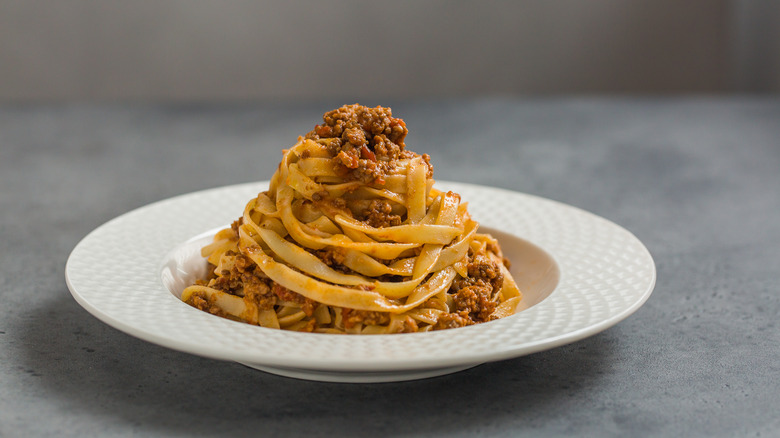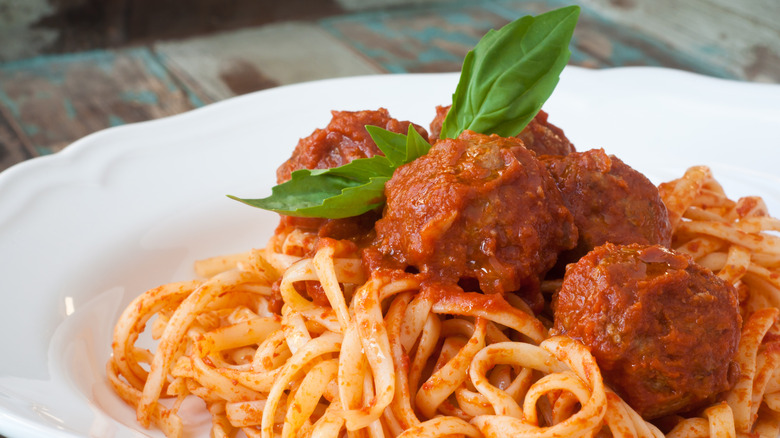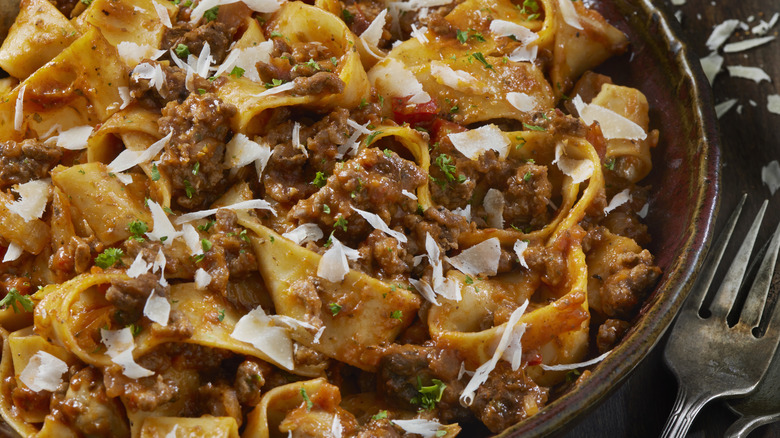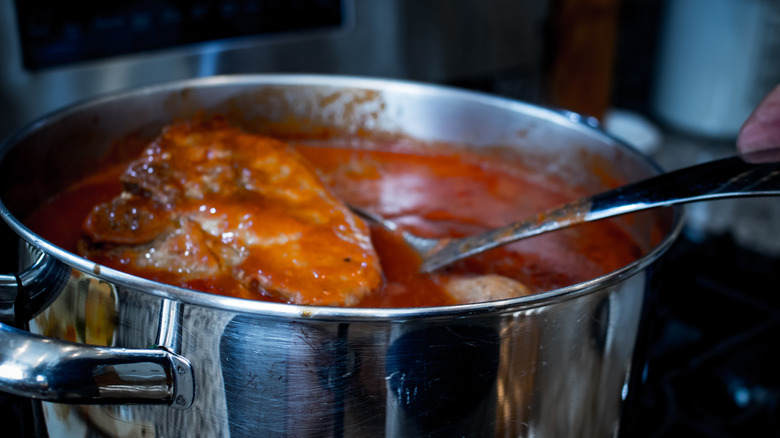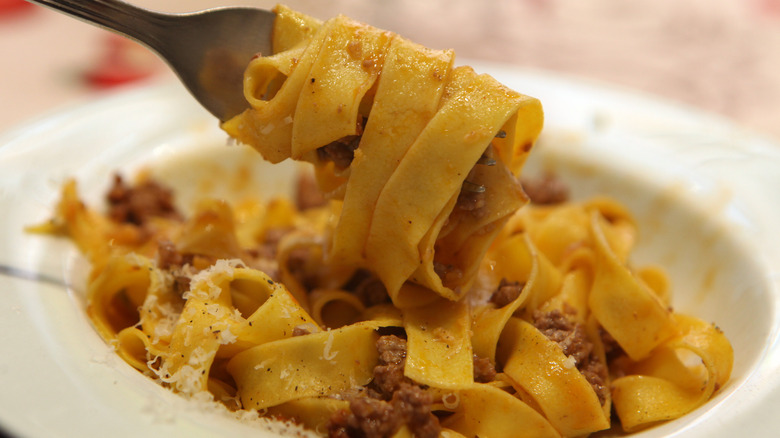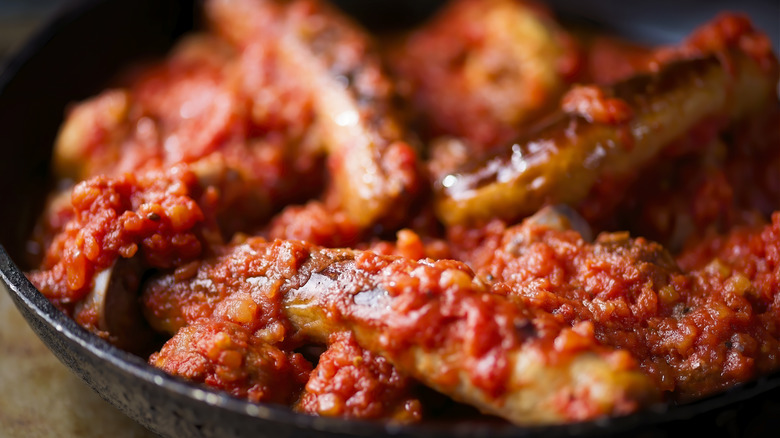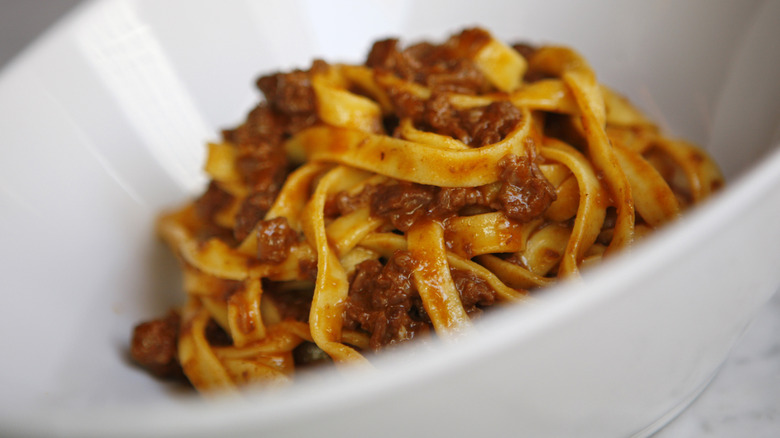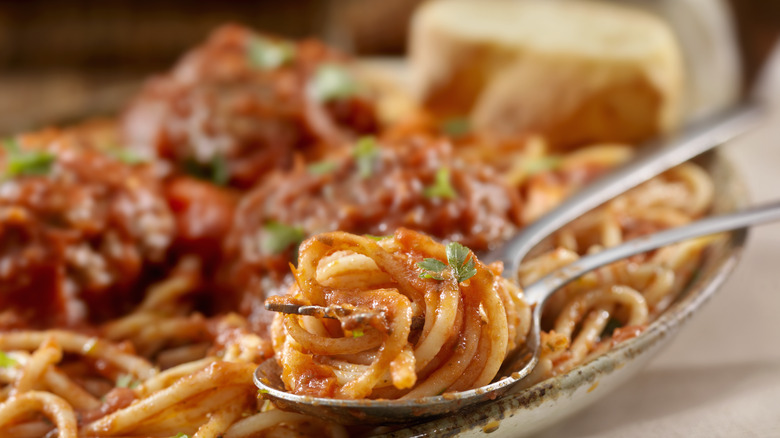The Meaty Difference Between Bolognese And Sunday Sauce
Looking for an excuse to get the family gathered around the dining table? A big Italian dinner should do the trick, and nothing says family quite like Sunday sauce. Sunday sauce is often confused with Bolognese, but the two are actually very different. It all comes down to the meat and tomatoes.
While both are pasta sauces, Bolognese places more emphasis on the meat. Sunday sauce, on the other hand, has a base of tomato sauce, which makes it more of a liquid than Bolognese. Despite their difference in appearance, flavor, and texture, many non-Italians conflate the two.
The sauces are further differentiated by the fact that they get paired with different types of pasta. Bolognese is most often served with long, ribbon-cut pasta, like tagliatelle or pappardelle, because their big, bold shape pairs well with the meaty sauce. These noodles usually have egg added to the dough, which is why they are sometimes referred to as egg pasta or egg noodles. Sunday sauce, on the other hand, is often paired with spaghetti, which is long and thin. Both types of sauce also pair well with tube-shaped pasta like ziti or penne, but you shouldn't serve Bolognese with spaghetti — the pasta will be too thin to effectively carry the chunky sauce.
What is Bolognese?
Bolognese sauce hails from the city of Bologna in Northern Italy. The sauce itself is believed to have originated in the 16th century among Italian nobles, but the first written recipe dates back to a famous 1891 publication by Pellegrino Artusi titled "Science in the Kitchen and the Art of Eating Well," which is considered by many to be the gospel of Italian cooking. In Bologna, they call Bolognese "al ragù" and, elsewhere, it's known as "ragù alla Bolognese." Ragù is a general term for meat sauces, not to be confused with the brand name, which sells meat and non-meat sauces alike. All Bolognese is ragù, but not all ragù is Bolognese.
Finely diced carrots, celery, and onions are added to Bolognese, which contribute to the body of the dish, while nutmeg is added for warmth. Although diced tomatoes are usually included, that isn't always the case, and they don't take on a more prominent role than the vegetables. The tomatoes provide body and flavor, but don't expect a thick tomato sauce to drizzle over the pasta. Bolognese has the chunky quality of a stew in that way without actually being a stew. Besides making for a fantastic pasta sauce, Bolognese is also quintessential to a good lasagna.
What is Sunday sauce?
Although it's often associated with Southern Italy, Sunday sauce is essentially an Italian-American phenomenon. Sunday sauce refers to a much thicker ragù eaten at big family gatherings on Sundays since it takes several hours to cook right. It's sometimes called Sunday gravy or simply Italian red sauce. It's much closer to a marinara sauce but, since it includes meat, it's considered a ragù.
Sunday sauce can be cooked with whatever meat you have on hand, whether that's beef, pork, or lamb. The type of meat varies wildly, but meatballs, Italian sausage, and bone-in beef ribs are all common choices. Some families may have a specific recipe they follow, while others might wing it with whatever is in the fridge that day. The through line for all Sunday sauces is a tomato sauce body that's thickened and made rich with big chunks of meat, which grow tender over several hours of cooking.
Bolognese traditionally uses ground meat
The meat is the star of the show when it comes to Bolognese, which means it matters a great deal what kind of meat is used. Bolognese uses ground meat pretty much across the board, though some claim that chopped meat is the way to go. That said, there's plenty of freedom when it comes to the specific type of meat being used. These days, you'll often find Bolognese made with ground beef, but more traditional recipes calls for a combination of ground beef and pork mixed with a dash of pancetta (a type of cured pork).
The original recipe from 1891 called for veal and pancetta, but veal has declined in popularity over the past few decades, so you aren't likely to see it included in many modern recipes. You should opt for meat with some fat on it since lean meat will dry out too quickly. Ground skirt, flank, or chuck steak will all work well.
Sunday sauce goes for big, tough cuts of meat
Sunday sauce is known for long, slow Sunday cooking, and the best meat to pair with that kind of slow-food mentality is big, tough cuts that can handle the heat. If there's such a thing as a Sunday sauce playbook, that's first on the list. But, it's a two-way street. Not only does the sauce tenderize the lean cuts of meat, the meat also contributes to the flavor and thickness of the sauce.
Italian sausages and meatballs are popular options since they add a lot of heft to the dish. If you buy ground beef and pork for Bolognese and change your mind, you can combine them with some bread crumbs to make Italian meatballs for Sunday sauce. You can also go full rustic with chunky slabs of flank steak or something similar. It's not uncommon to use bone-in pieces since the meat is often served on the side of the pasta. Beef short ribs, pork ribs, oxtail, and lamb shank are all great choices.
Bolognese isn't usually very saucy
There are so many ways to make different pasta sauces. If you've had Bolognese that's soupy enough to dip your grilled cheese sandwich into, don't worry, the pasta police aren't coming to get you. But if they were, they would tell you that true Bolognese resembles a minced meat stir fry more than a thick Italian chili.
The fact of the matter is that tomatoes play only a minor role in Bolognese, and tomato sauce is nonexistent in authentic Bolognese recipes. The Italian Academy of Cuisine included tomato puree in their updated rendition of traditional Bolognese, but the consensus is that this is a modern evolution of the sauce. Even with this addition, the end result comes out thick and chunky since most of the liquid is cooked away over the course of several hours.
Once you start dishing your Bolognese out with a soup ladle, you're getting closer to a Sunday sauce than Bolognese. Don't be fooled, though. Just because Bolognese is less saucy doesn't mean it's dry. Traditional Bolognese is cooked in a small amount of milk and, when combined with the juices from the meat, the result is a thick and velvety pasta sauce that's sure to satisfy.
Sunday sauce is thick, like marinara
We've said it before and we'll say it again: Sunday sauce can vary from recipe to recipe. The technique for how each cook gets there can be completely different, but the result is much the same. One cook may prefer to use good old-fashioned tomato sauce as their base, while another may choose to use add water to tomato paste. In either scenario, your Sunday sauce is going to end up with a lot more liquid volume than Bolognese.
The fact that Sunday sauce is big and, well, saucy has an impact on the meat. Even tough cuts of beef or lamb become succulently tender after several hours of braising in the marinara. It changes the whole dynamic of tomato and meat compared to Bolognese, where the meat needs to shine in so many other ways. You can even increase the thickness of the sauce by adding bone-in pieces of meat if you're worried it'll come out too thin.
Bolognese is served with egg noodles
For the uninitiated, the type of pasta being used for a dish may not seem like a big deal. After all, pasta is pasta — true and not true. Despite being made in similar ways, each style of pasta noodle does something different when paired with a sauce. Bolognese is rich and chunky with only a mild degree of sauciness, which means it won't pair well with thin noodles. A thin noodle just doesn't have enough body to latch onto.
That's why you'll see Bolognese paired most often with tagliatelle and other wide, ribbon-style pastas. There's more surface area for the Bolognese to cling to, which means you can get the noodles and the sauce together in the same bite. Tagliatelle is also a type of egg noodle, which are known to be more porous. Being porous lets it soak up all of the delicious flavors from the sauce that much easier instead of sliding right off. It should be noted that Bolognese is also often paired with round, hollow pastas like rigatoni, which also hold onto sauces well.
Sunday sauce is served with spaghetti
The idea behind Sunday sauce's pasta of choice uses the same logic as Bolognese but in reverse. Sunday sauce is thick with a big, juicy base for the noodles to sit in. Because the sauce will cover whatever pasta you use, your options are less limited. Spaghetti is the most popular choice because it provides plenty of chewy body to the sauce without being so big that it takes over the dish.
It's also good because the big chunks of meat in Sunday sauce are often kept whole and served on the side of the pasta. The meat is cooked in the tomato sauce to give the sauce flavor and body but, when served, it's often just the sauce enveloping the spaghetti noodles. Because the noodles aren't trying to hold big chunks of meat, their thinness isn't a problem. Just as with Bolognese, rigatoni is a popular substitute for spaghetti because it is so good at holding that delicious tomato base.
